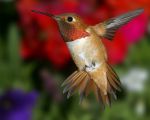
|
||
|
|
|
|
| Forgot Password | ||
Bird Facts
Posted by MariaBBB |
Added on : May 25, 2010 02:34am |
Last edited: June 14, 2010 03:05am | Viewed 3602 times
| 0 Comments | This article is also in birds
and birds
Birds are a group of warm-blooded animals with two legs and front limbs modified as wings. The characteristic feature of all birds is the feather.

The skeleton of birds and their internal organs are characterized but being reduced in weight and size to make them lighter as an adaptation to flight. The bones are hollow and thin walled. Many organs that were paired in other vertebrates and in the birdsí ancestors, such as kidneys, are reduced to one in birds.
There are over 9,200 species of birds known from around the world and they can be found in just about every habitat. In Australia there are 770 species of birds that have been identified as well as some extras that have arrived here by accident.
Birds evolved from small meat-eating dinosaurs around 150 million years ago. Itís a long and complicated story told in full in archives. The earliest undisputed bird is Archaeopteryx lithographica known from 145 million year old rocks from southern Germany.
The practice of keeping birds has been around for centuries, but aviculturists are still far from knowing all there is to know about our feathered friends. Even so, the knowledge that we have accumulated up to this point has brought to light many fascinating and sometimes amusing facts about the birds that we share our lives with.
Female Lovebirds often amuse their owners by shredding up the paper lining on their cage and placing the strips between their tail feathers. This is an instinctual behavior that would allow the bird to carry materials back to her nesting site for construction.
Migratory bird species fly in formation to conserve energy -- much like driving in a larger vehicle's slipstream can reduce the amount of gas you require.
Birds have a reduced sense of taste as compared to other animals, and science has yet to definitively prove that all bird species have a sense of smell.
A bird's feathers weigh more than its skeleton does.
The shape of a bird's beak directly corresponds to the type of diet it eats in the wild.
Precocial birds like chickens, ostriches, ducks, and seagulls hatch ready to move around. They come from eggs with bigger yolks than altricial birds like owls, woodpeckers, and most small songbirds that need a lot of care from parents in order to survive.
Air sacs may make up 1/5 of the body volume of a bird.
A bird's normal body temperature is usually 7-8 degrees hotter than a human's. Up to three-quarters of the air a bird breathes is used just for cooling down since they are unable to sweat.
A bird's heart beats 400 times per minute while resting and up to 1000 beats per minute while flying.
Pigeons can reach speeds up to 100 mph while swifts, doves, falcons, and sandpipers can approach 200 mph.
Hummingbirds eat about every ten minutes, slurping down twice their body weight in nectar every day.
The homing pigeon, Cher Ami, lost an eye and a leg while carrying a message in World War I. Cher Ami won the Distinguished Service Cross. Its leg was replaced with a wooden leg.
These are just a few of the many interesting facts about birds.





Be the first one to comment on this article